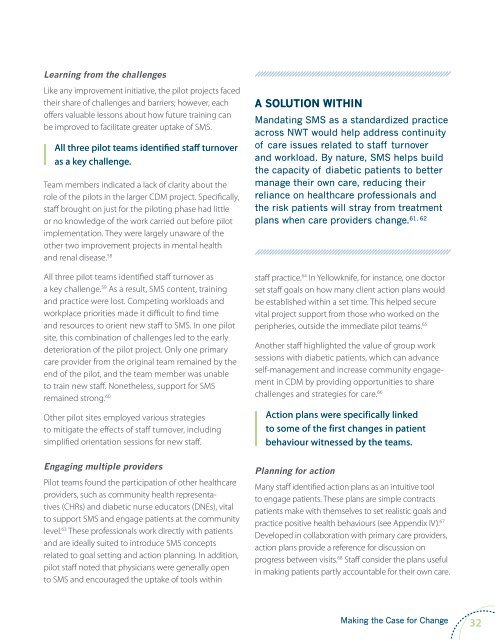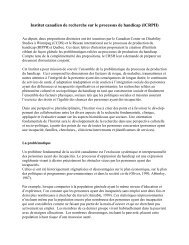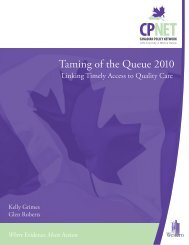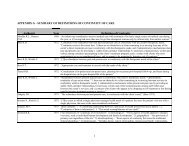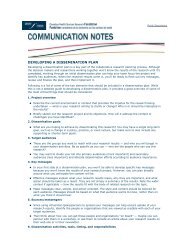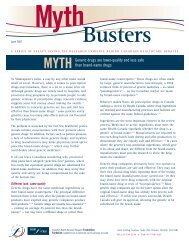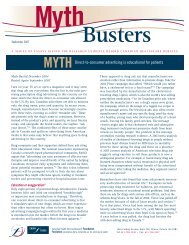Full Report
Full Report
Full Report
You also want an ePaper? Increase the reach of your titles
YUMPU automatically turns print PDFs into web optimized ePapers that Google loves.
Learning from the challenges<br />
Like any improvement initiative, the pilot projects faced<br />
their share of challenges and barriers; however, each<br />
offers valuable lessons about how future training can<br />
be improved to facilitate greater uptake of SMS.<br />
All three pilot teams identified staff turnover<br />
as a key challenge.<br />
Team members indicated a lack of clarity about the<br />
role of the pilots in the larger CDM project. Specifically,<br />
staff brought on just for the piloting phase had little<br />
or no knowledge of the work carried out before pilot<br />
implementation. They were largely unaware of the<br />
other two improvement projects in mental health<br />
and renal disease. 58<br />
All three pilot teams identified staff turnover as<br />
a key challenge. 59 As a result, SMS content, training<br />
and practice were lost. Competing workloads and<br />
workplace priorities made it difficult to find time<br />
and resources to orient new staff to SMS. In one pilot<br />
site, this combination of challenges led to the early<br />
deterioration of the pilot project. Only one primary<br />
care provider from the original team remained by the<br />
end of the pilot, and the team member was unable<br />
to train new staff. Nonetheless, support for SMS<br />
remained strong. 60<br />
Other pilot sites employed various strategies<br />
to mitigate the effects of staff turnover, including<br />
simplified orientation sessions for new staff.<br />
Engaging multiple providers<br />
Pilot teams found the participation of other healthcare<br />
providers, such as community health representatives<br />
(CHRs) and diabetic nurse educators (DNEs), vital<br />
to support SMS and engage patients at the community<br />
level. 63 These professionals work directly with patients<br />
and are ideally suited to introduce SMS concepts<br />
related to goal setting and action planning. In addition,<br />
pilot staff noted that physicians were generally open<br />
to SMS and encouraged the uptake of tools within<br />
A solution within<br />
Mandating SMS as a standardized practice<br />
across NWT would help address continuity<br />
of care issues related to staff turnover<br />
and workload. By nature, SMS helps build<br />
the capacity of diabetic patients to better<br />
manage their own care, reducing their<br />
reliance on healthcare professionals and<br />
the risk patients will stray from treatment<br />
61, 62<br />
plans when care providers change.<br />
staff practice. 64 In Yellowknife, for instance, one doctor<br />
set staff goals on how many client action plans would<br />
be established within a set time. This helped secure<br />
vital project support from those who worked on the<br />
peripheries, outside the immediate pilot teams. 65<br />
Another staff highlighted the value of group work<br />
sessions with diabetic patients, which can advance<br />
self-management and increase community engagement<br />
in CDM by providing opportunities to share<br />
challenges and strategies for care. 66<br />
Action plans were specifically linked<br />
to some of the first changes in patient<br />
behaviour witnessed by the teams.<br />
Planning for action<br />
Many staff identified action plans as an intuitive tool<br />
to engage patients. These plans are simple contracts<br />
patients make with themselves to set realistic goals and<br />
practice positive health behaviours (see Appendix IV). 67<br />
Developed in collaboration with primary care providers,<br />
action plans provide a reference for discussion on<br />
progress between visits. 68 Staff consider the plans useful<br />
in making patients partly accountable for their own care.<br />
Making the Case for Change<br />
32


